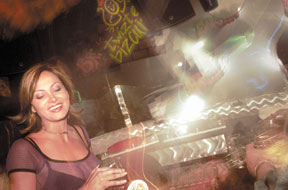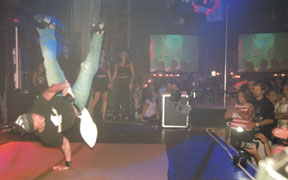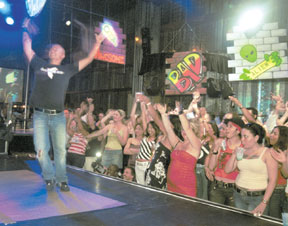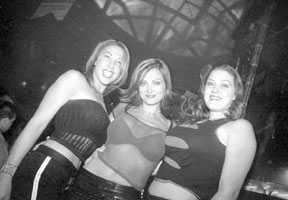 |
Friday, July 18, 2003 |
| LOCAL NEWS |
| SHRAPNEL |
| FEATURES |
| LETTERS |
| CITYPICKS |
| CALENDAR |
| MUSIC |
| FILM |
| HOROSCOPES |
| BOOKS & LIT |
| ART |
| THEATER & DANCE |
| DINING OUT |
| LAST CALL |
| EATS & DRINKS |
| ARCHIVES |
| ABOUT US |
|
These are the breaks: Is breakbeat the new sound of the Las Vegas underground?
By Matt Kelemen Photos by Bill Hughes I first met Gumbee at Ra, where DJ Icey, "The King of the Funky Breaks," was sharing a bill with Baby Anne, the "Bass Queen." DJ Icey and Baby Anne both come from Florida, as does Gumbee, and draw on the bass-heavy sound of breakbeat, a style rapidly gaining momentum in the Las Vegas club scene. Rapidly, that is, in a relative sense. Breakbeat began taking its place alongside more established electronic music genres nearly a decade ago, rising simultaneously in scenes on both coasts. In Florida, DJ Icey was the prime mover, bringing breakbeat to the masses at raves and relentlessly churning out vinyl singles through his own Zone and Tree recording labels. In Southern California veteran DJ Simply Jeff helped lead the way, with another breakbeat enthusiast named DJ Oscure furthering the cause by forming the Los Angeles Breakbeat Association. But in Las Vegas, a nightlife island unto its own, styles evolve slowly. The mega-casinos need to keep their dancefloors filled, and the formula for that is familiarity in both song and style. That's why you can conceivably hit three clubs on one evening and hear the same three songs in the same order (say, "It Takes Two" by Rob Base, followed by play-it-safe house and trance tracks). In other words, while Las Vegas has a
thriving nightlife industry it does not have a comparatively
progressive dance scene. House, trance and hip-hop get the party
started at Ra, Studio 54, Bikini's, Baby's, et. al., and hard house
and techno enter the mix at the after-hours clubs to keep people on
their feet into the early morning.
Although it is increasingly infusing its way into the clubs, breakbeat has yet to penetrate the mainstream. On a night like this, it's hard to see why. The crowd is pumped, hyped on the reputation of the DJs on the double-bill, and further incited by the looped breaks and mixed beats. At one point Gumbee is by himself, leaning against a railing and gazing at the crowd. I ask him about the trajectory of his own DJ career, and he mentions some gigs and a lot of out of town weekend travel. But he laments the fact that club owners are resistant to give breaks a chance. "Have any DJs been able to bring breakbeat to the masses in Vegas yet?" I ask. "No," he says, without turning his gaze from the crowd. "But I will."
I see Gumbee again several months later over Memorial Day weekend, when he throws a birthday party for himself at Sevilla. The lineup is populated by Florida-based DJs such as Huda Hudia and Tony Faline, as well as Vegas-based breakbeat aficionados Joy, David Christian and That DJ Girl. Gumbee is the promoter tonight and, although it's early and the event is personal and fairly low key, he is looking kind of nervous as he smokes a cigarette by the entrance and watches people trickle in. "Now I remember why I don't do these things," he says. "The last time I promoted an event was back in 1994." Gumbee is a fairly big guy, husky and barrel-chested but solid, with shoulder-length blond dreadlocks. Physically, he stands apart from most Vegas DJs, who generally look like anybody else in a club. But he also stands apart in other ways. Since arriving in town two years ago, Gumbee has refused to move in a conventional direction to further his DJ career, a philosophy that can lead to commercial suicide in Vegas -- and a one-way plane ticket home. It helps that his reputation as a producer preceded his arrival in town, but his devotion to his chosen style goes back nearly a decade. "I was doing a lot of shows in Florida back in '94, mostly South Florida," he says. "Back then, breaks weren't as prevalent as they are now in Florida. It was the underground concept, the idea, the vibe. That's what I was really into." Trance music, a style pioneered by U.K. DJ Paul Oakenfold, dominated clubs at the time. Gumbee was a trance fan. "One night I went to another club called the Parthenon and I heard my first breaks, and it completely blew me away. It was DJ Icey. His first tracks completely turned me on to breakbeat. Ever since then I've been all about the breaks." The breaks. Broken beats. Imagine the music
you hear at clubs, minus the hip-hop choruses and pop-chart hooks.
Most of the time you're hearing house music, which traces its
lineage directly back to disco, and its more accessible cousin
trance. The beats pound at an even tempo that nearly anyone can
dance to. Now break up the beat. Think of the "breaks" in classic
hip-hop songs, looped over and over with instrumental backup or
vocal samples mixed in. Think of freestyle music, the predominant
dance genre of the pre-rave era '80s, that was represented by
Miami-based Pandisc Records, songs such as "Lookout Weekend" and
singer Stevie B. Think of booming-bass emanating from trunk-enclosed
woofers in heavy traffic. Think James Brown's "Funky Drummer." Think
Bo Diddley beats as opposed to Chuck Berry, and you have breakbeat
as it compares to conventional house.
Breakbeat, known early on as "funky breaks," took over the Central Florida scene, becoming the predominant sound in clubs that played rave music. Icey was the main resident DJ at the Edge -- Orlando's biggest club at the time -- and a former finance professional. He organized the first downtown raves, and made sure up-and-coming breakbeat enthusiasts shared the bill. Icey loved the breaks too, and started spreading the gospel with his own series of breakbeat 12-inch singles. Small labels sprung up, and breakbeat was soon a cottage industry. Breakbeat became the first Florida sound since K.C. and the Sunshine Band convinced the nation to collectively "Shake Your Booty" -- and Icey was crowned king. But Central Florida -- which had the first modern-day, underground dance scene outside of New York, Los Angeles, Chicago and Detroit -- became the battleground for the initial anti-rave movement that swept the nation's club industries. By 1997, local governments enacted draconian measures in order to harass after-hours venues, and undercover agents infiltrated the dance floors. The smart DJs began leaving town, and the ones who stayed saw the remnants of their scene collapse. But the breaks lived on. Gumbee made it onto the touring circuit before that door began to close in the late '90s, finally shutting for good on Sept. 11, 2001. Gumbee went west. He credits Club Utopia owner David Cohen for bringing him to Vegas. Cohen had popped a CD of Gumbee-produced Florida breaks into his stereo, and asked Icey if he knew the oddly named DJ. "Icey said, 'Sure, he's on my label,'" recalls Gumbee. "Cohen said, 'I'd like to have him come out here to play.' So I came out for a last-minute vacation, talked to him, went around the clubs. I was not hearing what needed to be heard as far as breaks go, so I said, 'Fuck it,' packed my shit up, and moved out here." Club Utopia allowed Gumbee to stick to his guns and maintain a breakbeat-only set, but a fire and increasing competition contributed to the collapse of the pioneering club. Gumbee occupied himself by producing tracks and touring on weekends, waiting for a club that was willing to let him spin breakbeats for the masses. Meanwhile, Adam Webb -- another Florida expatriate -- had been spinning breaks in the after-hours joints for several years. He was instrumental in turning Las Vegas' DJs on to the new style, including nascent DJ David Christian. "I love breaks," says Christian. "You watch dancefloors when breaks come on, and if it's a crowd that knows 'em it's one of the most entertaining dancefloors you'll ever watch." Gumbee has stood firm and continues to play breakbeat sets exclusively. In May, Twizted Bizcuit produced an all-breakbeat party at Ra called "Orbit." Gumbee, Tony Faline and Ra resident DJ Noey were on the bill, and the event was a success -- so much so that Twizted Bizcuit lined up another party for July 17. According to Gumbee, a lot of locals heard breakbeat for the first time that May night -- and liked it. "In my opinion, breakbeat is more universally acceptable. It's got influences from all genres. You've got rock drumbeats; you've got psychedelic sounds; you've got funk and soul instruments. Breakbeat is a combination of all different genres and I think that's why people enjoy it so much." Weeks later, I ask Gumbee to come along on a walk-through of ICE, a lavish club that will soon open on Harmon Avenue a few blocks east of the Strip. Longtime clubbers would recognize the building as the former location of the Drink. Promoter Michael Fuller gives us the tour, taking us step-by-step through the new venue, which promises to be the next step in the evolution of the club scene -- if the music goes in the sophisticated, progressive direction that Fuller describes. I ask him if there will be breakbeat included in the music program. "Yeah, we won't have a breakbeat night per se," says Fuller. "But all of our DJs will be spinning extended sets. So if Gumbee comes out to play ... he'll be welcome to spin breakbeat."
I came out here, and to me it was like taking a guy from New York and bringing him to Mayberry," says longtime Vegas DJ Frankie Anobile. "I was ready to see Sheriff Taylor." Anobile's talking about the Vegas of a
quarter-century ago, when he arrived as a teenaged drummer who had
just been exposed to turntables and beat mixing in the discos of his
native Brooklyn. "Back then there were only 250,000 people in this
town, and it was a culture shock!"
Anobile, his friend Mike and I are pulling into a space inside the parking garage at Barbary Coast, where a DJ spinoff at Drai's is on the evening's itinerary. One of the residents at the after-hours club is leaving, and a half-dozen aspiring DJs are on hand to try out for the vacancy. At least one DJ, another Florida transplant named Doug Lascivious, plans on spinning an all-breaks set. Anobile, now music director for Studio 54 and Tabu (with 14 DJs on his roster), is somewhat of a local dance scene historian. At 16, he used his brother's I.D. to get a job at a nightspot called the Brewery. There were only a handful of clubs in the valley at the time, as opposed to the 65-plus venues that compete for business now. A background in drumming made it easy for him to make a transition into DJing. And according to Anobile, he was one of the first in town who could "beat-mix" properly. "There was only about three [DJs] who mixed," he recalls. "Out of the 12 DJs who worked here consistently, there was only about three who mixed." This era was ground zero for DJ culture. Prior to the mid-'70s, there was no difference between a radio DJ and a club DJ. You played a song, faded it out as it reached the end, and started the next song. Disco and hip-hop changed all that. In clubs across the country, DJs were employing extended mixes to keep people dancing to popular songs and began to segue, matching the beats per minute from one track to another, rather than breaking the momentum with a stop-start or a sloppy fade. At block parties in the Bronx and Brooklyn, DJs like Africa Bambaata and Kool Herc were taking it a step further, looping and scratching and turning the mixing board itself into an instrument. Disco reigned until almost overnight the high-energy, four-on-the-floor sound gave way to the slower tempos of '80s funk and euro-synth music. But the die was cast for a future underground culture. By the end of the decade, techno had exploded and Vegas quickly developed an underground. "What was going on here in '89 was techno," says Anobile. "The original phase of techno, which is a lot like hard house now." And the cult of the DJ was born. While
turntable techniques are less complex (with a few exceptions) than
instrument techniques, a DJ still has to possess a certain degree of
skill -- and the best DJs have the most skills. A sense of rhythm is
most important, followed by a spontaneous sense of imagination.
Knowledge of recorded music, the ability to read a crowd, stamina
for late nights, and a knack for self-promotion are all essential.
The DJ is the tastemaker, the manipulator. You play your filler
early, then start to play the familiar songs after people have had a
few drinks. Once you get dancers on the floor, then you have the
option of playing newer, more underground records.
If you succeed, people have a good time. If you fail, people clear the floor. DJs like Anobile and Hollywood, who drops by as our interview concludes in the offices deep inside Studio 54, got in on the ground floor of a nightlife scene in transition. By the time Elvis died in 1977, the days of the classic Vegas lounge-style act were numbered. The stage was set for the modern DJ to assume the position previously held by bandleaders. Off-the-Strip clubs such as Tramps and the Shark Club prevailed, as the hotel-casinos still looked at nightclubs as a distraction from gambling. But then Club Rio opened in 1995, drawing the masses. And when Club Utopia opened on the Strip just north of the MGM Grand, it attracted crowds to an extent that the casinos had to take notice. Thus, the MGM opened Studio 54. The Luxor opened Ra. Baby's at the Hard Rock, C2K at the Venetian, Rain in the Desert at the Palms. Suddenly, nightclubs made Vegas the entertainment capital of the world again, 40-plus years after Frank, Dean and Sammy tore up the town. Except this time it's DJs making the pilgrimage instead of trained musicians, singers and comedians. But the legacy of what it takes to succeed has not changed much. You have to be able to appeal to the masses. There are an estimated 5,000 club DJs in Las Vegas, according to Hollywood, and few open positions. So what does it take to make it as a DJ in the valley, especially if you have a passion for a particular style such as breaks? "I have absolutely nothing against any DJ that wants to be true to their form," Hollywood says. "But when the time comes and they say to me, 'I'm not making any money,' then I give them the advice that I'm about to answer your question with: You have to be extremely open-minded, and you have to be extremely versatile. And that's how you make it in Las Vegas. ... The scene isn't here for the DJs. The DJs are here for the scene." At the same time, Hollywood recognizes Gumbee as an up-and-coming talent. "Gumbee is a spectacular producer. I know Gumbee very, very well. ... He's one of the better producers of breakbeat that I've heard in the last 10 years. Awesome, awesome, awesome." Hollywood -- music director at Rain, ghostbar and Skin -- cites DJ Maze for introducing breakbeat to Las Vegas back in 1995, and gives credit to Webb and Christian as having kept it alive in the clubs. "Adam Webb is definitely the one who made it as big as it is now in Vegas," he says. "And David Christian has a lot of passion for the breaks, but he spins everything because he's one of the most versatile DJs in town." For now, breakbeat remains an underground
phenomenon. "You could never carry a club with breakbeat," Hollywood
says. "It's a specialty type of music. The good part about breakbeat
is that anybody who likes to dance to it, and anyone who listens to
it, has the old-school feel. And breakbeats generate from the old
school. Anybody who understands the culture and the music from back
in the '70s and the '80s can definitely fly with the old-school
feeling, and it can definitely brings energy to a dancefloor. But
you can't run a club on that [by itself]."
Hollywood is willing to invest in the future of the genre by promoting an open turntable night with Christian at the Emergency Room on Decatur Boulevard, where breaks gets equal time with trance, house, drum 'n' bass and reggae. "I think there's a great following among the locals for breaks," says Christian. "I don't think there's one style of music that can hold a nightclub by itself, other than hip-hop. You go to any of the major nightclubs, and that's the one consistent thing that you're going to hear. ... But when Robert Oleysyck, 10 years ago, was playing at Utopia, no one said: 'Trance can make it in a major nightclub.' Now you hear it in every major nightclub."
So it looks like breakbeat will bubble just beneath the surface of the mainstream in the valley for the time being. While it continues to make inroads into the sets of established DJs like Paul Oakenfold, Adam Webb continues to spread the gospel after hours at Seven's "Alesium" and Christian mixes breakbeat into his weekend sets at Bikini's. Breakbeat is the sound of the new underground. And in Vegas, where just about everyone comes from somewhere else, an underground can help create a sense of community. This is especially evident at Ra on a recent Friday night, where Twizted Biscuit holds its second all-breakbeat party, "Funktion." Breakdancers practice their moves beneath signs that hang from the ceiling and have "ELECTRO" and "BREAKBEAT" written on them in a day-glo, graffiti-style font. Taggers stand at the ready waiting to deface the large faux-brick panels on the stage. Opening DJ Noey Morgan is spinning an update of Donna Summer's "I Feel Love." The classic Giorgio Moroder production lends itself well to a breakbeat remix. Gumbee is on hand, as are fellow Las Vegas breaks DJs Lascivious and J. Funk. Simply Jeff and Oscure headline, and spin the party further and further into an electro-bass frenzy. The weekend crowd is a mix of locals and tourists, but it seems like there are more people who know each other than usual. They seem slow to warm up to the sound, needing those first drinks to loosen up. But after awhile the dancefloor fills and, revved on by a breakdancing contest, the ladies and gentlemen of the evening start to move with the beats. It's boom-BAP-boom-ba-doom-BAP, rather than the four-on-the-floor Boom-Boom-Boom-Boom of house. It's hip-hop minus the braggadocio. It's personal expression, a breakbeat canvas on which a DJ can express his or her own individual history of influences. It's Simply Jeff throwing in Manfred Mann's "Blinded by the Light" -- and making it work. It's that girl dancing in her own world in the V.I.P. area, as the evening wears down, making her own solitary connection to the music and completely disinterested in anyone outside of her bubble. Of course, I have to burst it. "What do you like about this music?" I ask. "I like hip-hop," she says, indicating the current trajectory of the set. "But I really like this scene." Matt Kelemen is CityLife's film editor. He can be reached at 702-871-6780 ext. 395 or mkelemen@lvpress.com.
| |||||||||
| Copyright © 2003 Las Vegas City Life |
 | |||||
|
|||||
CLASSIFIED PLACEMENT
Place your classified ad in any of our publications using our online ad placement form.






